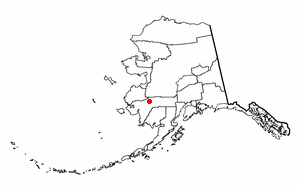Lower Kalskag, Alaska
|
|
Lower Kalskag is a city located in Bethel Census Area, Alaska. As of the 2000 census, the population of the city is 267.
Geography
Lower Kalskag is located at 61°30'49" North, 160°21'33" West (61.513735, -160.359050)Template:GR.
According to the United States Census Bureau, the city has a total area of 4.5 km² (1.7 mi²). 3.3 km² (1.3 mi²) of it is land and 1.1 km² (0.4 mi²) of it is water. The total area is 25.58% water.
Demographics
As of the censusTemplate:GR of 2000, there are 267 people, 66 households, and 54 families residing in the city. The population density is 80.5/km² (208.2/mi²). There are 79 housing units at an average density of 23.8/km² (61.6/mi²). The racial makeup of the city is 4.49% White, 0.00% Black or African American, 88.76% Native American, 0.00% Asian, 0.00% Pacific Islander, 0.00% from other races, and 6.74% from two or more races. 0.00% of the population are Hispanic or Latino of any race.
There are 66 households out of which 62.1% have children under the age of 18 living with them, 47.0% are married couples living together, 24.2% have a female householder with no husband present, and 16.7% are non-families. 15.2% of all households are made up of individuals and 1.5% have someone living alone who is 65 years of age or older. The average household size is 4.05 and the average family size is 4.53.
In the city the population is spread out with 44.9% under the age of 18, 13.5% from 18 to 24, 22.1% from 25 to 44, 15.4% from 45 to 64, and 4.1% who are 65 years of age or older. The median age is 21 years. For every 100 females there are 96.3 males. For every 100 females age 18 and over, there are 98.6 males.
The median income for a household in the city is $25,625, and the median income for a family is $27,500. Males have a median income of $16,667 versus $36,250 for females. The per capita income for the city is $7,654. 40.6% of the population and 36.7% of families are below the poverty line. Out of the total population, 51.4% of those under the age of 18 and 35.7% of those 65 and older are living below the poverty line.

